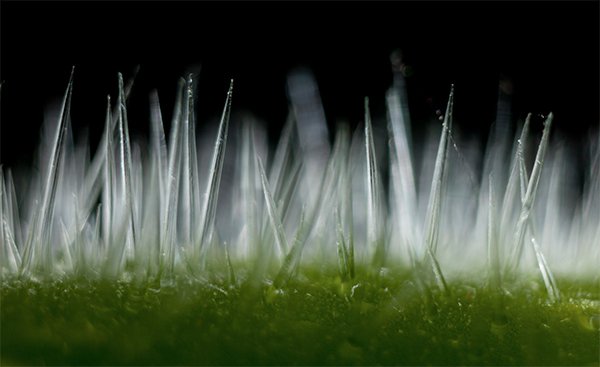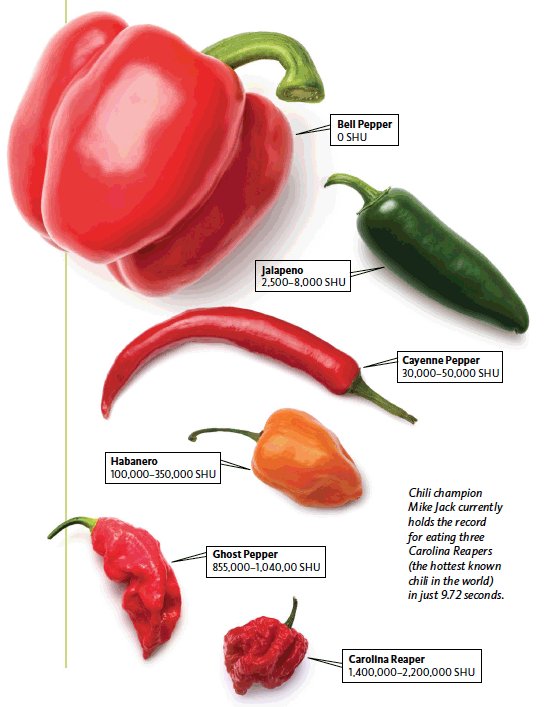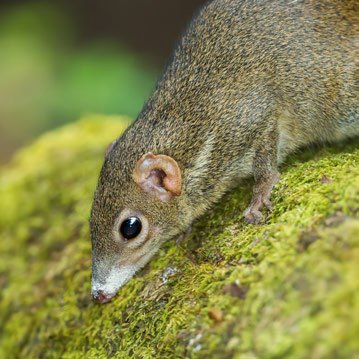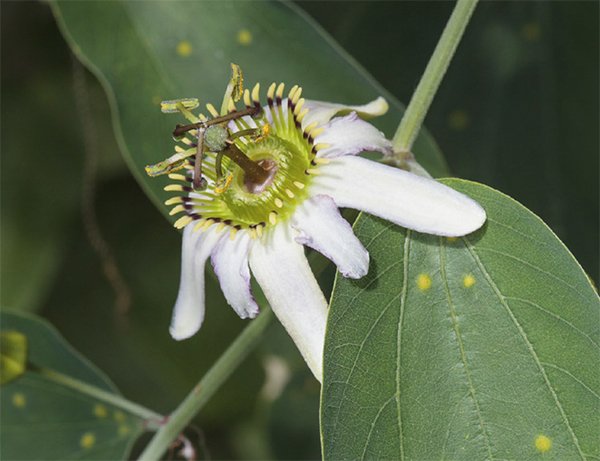Plants—Standing Their Ground
In a fallen world where it’s eat or be eaten, even plants need protection.
Imagine the garden of Eden in the week after creation: buzzing bees, fluttering butterfly wings, and the delightful aroma of recently created plants lush with fruits and vegetables. Adam and his bride traverse the garden, innocently strolling through plants of all kinds until they discover raspberry bushes, where they devour handfuls of delicious berries. Around the couple, a variety of animals join in a similar vegetarian banquet. None is in danger of being poked, impaled, or poisoned by their plant feast.
Our imaginary scenario is consistent with what we read in Genesis 1:29–31. Scripture tells us that every creature was to eat plants, and God called his completed creation “very good.” That’s a far cry from what we see today. One walk through the woods can quickly inform your ankles that this very good world has gone bad. As a result of Adam’s sin, God cursed the entire creation (Romans 8:20–22). One of the more visible ways that plants were affected is specifically mentioned in the text: “Thorns and thistles it shall bring forth for you” (Genesis 3:18). Simple pleasures such as picking raspberries became hazardous without adequate, protective gloves.
It is reasonable to conclude that Genesis 3:18 encompasses more than just thorns and thistles when referring to the effects of the curse on the plant kingdom. It would have taken several volumes the length of our Bible to completely explain how every created kind of plant was affected. In fact, we’re still learning the terrible yet fascinating ways that plants defend themselves. We think of the weeds that choke our vegetable garden and cling tenaciously to the ground, the parasitic plants that drain nutrition from our trees, and the thorns that pierce our hands.
Hordes of voracious plant eaters—including humans—stay alive by chowing down on vegetation. Though we enjoy juicy burgers, fried chicken, savory steaks, and bacon, the meat we eat comes from animals that were, for the most part, plant eaters. And we must balance our diet with the vegetables, fruits, and grains from plants. We also look to plants for products such as textiles, pharmaceuticals, construction material, and chemicals. Most animals and insect species rely on vegetation for food and water. Even bacteria and fungi piggyback on plants to receive nutrients. Everything, it seems, wants a piece of the plant kingdom.
You might get the impression that the inclusion of thorns and thistles into the creation served only one purpose—to punish Adam. However, while punishment surely was the primary purpose, these effects also provide balance and protection for plants in a fallen world.
Though plants are rooted in the soil, unable to flee, hide, or dodge, the Creator has programmed plants with an array of methods for defending themselves against invaders.
Physical Defenses
First off, plants possess physical defenses. Obvious examples are the sharp spines found on cacti and the prickles on the stems of rose bushes. These do well to defend against larger herbivores.
Other plants, such as lamb’s ear, are covered with fine, hairlike protrusions called trichomes, which help to ward off many types of smaller insects. Trichomes give kiwis and peaches their “fur.”
Some plants employ a physical defense called raphides. These are tiny, needle-like crystals found in the tissues of such plants as rhubarb and pineapple that can cause irritations inside an herbivore’s mouth. Aside from causing irritations, the tiny wounds created by raphides pose avenues for infections to enter.
But pointy protection isn’t the only self-defense plants have. Leaves may be covered in a waxy cuticle that reduces an insect’s ability to traverse securely on the leaves while also making the leaf less palatable. Many plants possess the ability to quickly thicken their cuticle layer in response to being munched on.
Tree bark is another excellent physical defense. The nonliving outer layer tends to be extremely hard, creating a nearly impenetrable barrier. We would be wise not to carelessly remove chunks of bark since trees depend on it to ward off attacks from a variety of pests.
Chemical Defenses
Many plants fend off herbivores by producing poisonous compounds within their tissues. Some poisons are related mostly to taste but others to touch. Anyone who has had a run-in with poison ivy understands this touch defense quite well. The leaves and stems of this plant release an oil when something or someone brushes up against them, resulting in an unpleasant allergic reaction. A nasty rash accompanied by maddening itching typically lasts for up to several weeks.
Stinging nettles employ a combination of a physical defense (leaves covered with tiny sharp barbs) and a chemical defense. The barbs can inject irritants into the puncture wounds on unwary herbivores, resulting in an irritating rash. As an extreme example, the Australian stinging tree (Dendrocnide excelsa) releases neurotoxins similar to those found in spider bites. The venom binds to the pain receptors in an herbivore’s nervous system, causing excruciating pain that can persist for months.

Photo NATURE PICTURE LIBRARY/ALAMY STOCK PHOTOS
The Australian stinging tree is covered with tiny hairs that inject a toxin which can cause pain for months.
Milkweed plants produce a viscous white substance (hence the name milkweed) that can clog the mandibles of certain chewing insects. This milky substance contains cardiac glycosides, a substance that upsets the digestive tract of many animals. Interestingly, monarch butterfly caterpillars can safely consume and absorb this substance into their bodies, making them distasteful to many animals and birds.
Even the cheery geranium turns into a lethal killer, producing an acid in its petals that disables its arch enemy, the Japanese beetle. Minutes after a bite, the unsuspecting insect is left paralyzed and defenseless against its own predators.
Chemical defenses leap to another level of complexity in this next example. When under attack by insect herbivores, some plants release volatile organic compounds (VOCs) that help to make them less palatable while also acting as a type of chemical Morse code, warning neighboring plants of an impending attack. This in turn initiates the production of VOCs in the neighboring plants. Tobacco plants release compounds that act as direct repellents to various moths, preventing them from laying eggs on the plants.
Some of the VOCs emitted by plants attract parasitoid wasps—the insect version of calling in the air force. Tomato plants put out the call when attacked by tomato hornworm caterpillars. Guided by the powerful scent of the VOCs, the wasps fly in and lay their eggs on the marauding caterpillars. A short time later, the wasp’s larvae consume the caterpillars from the inside out.
You may not have thought of this before, but many of the spices and seasonings that we use to give our meals some zing are the chemical defenses of plants. For example, the mustard many of us enjoy on our hot dogs is very toxic to many animals. Thankfully, the mustard we consume has been purposefully selected to be less irritating to our digestive tracts.
Peppers, Spice, and Not Everything Nice
Peppers are some of the spiciest crops on the planet. But did you know that a pepper’s spice is a defense mechanism? Plants protect themselves from predators by packing heat. A chemical called capsaicin surrounding pepper seeds repels insects and predators.
This defense doesn’t stop some people from eating super hot peppers. In fact, some people compete to see who can survive the spice. But if you took your temperature after eating a pepper, you’d see no change. The reaction you have to hot peppers is just a sensation. Capsaicin sends pain signals to the brain, “tricking” the cell receptors that usually sense temperature. The more heat you eat, the less sensitive you’ll become to spiciness. But be careful—make a habit of popping hot peppers, and other food will begin to taste bland.
The amount of the heat in a pepper is measured in Scoville Heat Units (SHU). How much heat can you handle?

Mutualism
Other plants depend on mutualism with ants—a situation like hiring a security team. For example, acacia trees harbor pugnacious ants that attack any herbivore large or small that would seek to damage the tree. The ants also destroy vines attempting to attach themselves to the acacias as well as plants growing near the base of the trees. The ants get a nice home from this relationship, and the trees are well protected by the ants. But in a fallen world, both parties in this type of arrangement don’t always keep their end of the bargain.

Photo ALEX WILD
Laced with a special enzyme, the nectar of the Central American acacia tree is addictive to ants. Unable to consume other sugars, the ants are bound to defend the tree against weeds and predators.
The Inga tree native to Peru is home to big-headed ants that aggressively drive off insects that might seek to consume the leaves of saplings. Because these small trees grow in a highly competitive environment for space among plants, they can use all the help they can get. The tree “invites” the ants to reside among its leaves by producing a sweet nectar from tiny bowl-like structures called nectaries. However, in this instance, the ants are open to bribes and can turn on their plant host for a better offer. Caterpillars of a Nymphidium butterfly entice the ants to allow them to dine unhindered on the leaves of the plant—inhibiting the Inga tree’s health and growth. The caterpillars have two tentacle nectaries on their backsides. When the ants tap the nectaries, they secrete a sugary substance that is a by-product of the caterpillar consuming the leaves.1 It’s a win-win for the caterpillar and the ant—but for the tree, it’s a deal gone bad.
Clever Animals That Circumvent Plant Defenses
These cunning critters go on the offense to get around a plant’s defense.

Caterpillar Photo DENIS CRAWFORD/ALAMY STOCK PHOTOS
Roll with It
Caterpillars from the families Pyralidae and Ctenuchidae can steamroll their way to a meal. They roll mature leaves around a growing bud of the neotropical plant Psychotria horizontalis. Rolling the leaves shades the bud from the sun, preventing the leaves from getting tough and reducing the bitter tannins from reaching the bud—all while maximizing a nutritional gain of nitrogen for the caterpillars.

Prickles and Planthoppers
What people often mistake for thorns on roses are actually prickles, protrusions from the plant’s outer layer. Some species of planthoppers are small enough to pose as prickles on rose plants to elude predators. This allows them to safely enjoy all the sap they can eat.

Made That Way
The Chinese tree shrew is the only mammal that enjoys hot peppers. When researchers presented the shrew with various foods to choose from, the animal was partial to the hot peppers. While other mammals have a pain receptor that is activated by capsaicin (the chemical surrounding pepper seeds), this receptor is less sensitive in the Chinese tree shrew, preventing this animal from feeling the burn.

Two Is Better Than One
The larvae of the Colorado potato beetle sometimes “spit” digestive proteins onto the plants they plan to eat. But tomato plants can detect these chemicals and produce proteins that inactivate the insect’s secretion. To double down on the attack, the larvae team up with bacteria that help them suppress the plant’s defense mechanism. This symbiotic relationship benefits both parties. The beetle gives the bacteria a warm home inside its mouth, while the bacteria help the beetle beat the plant’s defense.
Hatching a Plan
Sometimes plants deal with an herbivore before it becomes a problem by destroying its eggs. Some mustard plants summon parasitic wasps to lay eggs in the herbivore’s eggs. Other plants deploy chemicals that kill the eggs. When cicadas insert their eggs into a cherry tree, a sticky residue fills the egg chamber, inhibiting the egg from hatching.
Other plants, including potatoes and beans, are programmed to sacrifice a part of themselves to get rid of pests. When the plant detects eggs on its leaves or stems, it increases the production of molecules that kill the leaf’s cells in the area where the eggs are attached. In time, the eggs fall off or dry up.
But instead of waiting for insects to lay the eggs, some plants deter the egg layers by making it look as if the spot on the plant is already taken. The vines of passion flowers feature structures that look similar to butterfly eggs. When a butterfly is searching for a place to lay its eggs, it will move on to a “less crowded” plant.

Photo GEOFF KIDD/SCIENCE SOURCE
The passion flower discourages butterflies from laying eggs on its leaves by featuring yellow speckles that resemble eggs, tricking the butterfly into thinking the leaf is taken.
This defensive behavior gives the impression that plants are thinking, but this is clearly not the case. Rather than nerves or a brain, plants use chemicals, minerals, and fluid to respond to a stimulus like motion or attack. The “thinking” came from an outside source—the mind of God. These mechanisms have been impressed upon the matter that makes up the plant. For example, a motion detector might appear to be thinking when it is set off by the movement of a burglar. But the motion detector did not think at all. It is merely the by-product of an outside intelligence that programmed it to “behave” accordingly.
We’ve only scratched the surface of the weapons in the plant kingdom’s arsenal. But something becomes clear as we observe these defense systems: they did not evolve by chance mutations occurring over time. They are intricate and purposeful, the product of a vastly intelligent source. They also confirm the historical account of the fall recorded in Genesis 3.
But we must always keep in mind that no matter how exquisitely these defense systems function, they were not operational in the original creation. Thorns, thistles, toxins, and a myriad of other plant defenses were not yet present to cause harm and even death in some instances. The world was perfect and without sin and suffering.
But even after the fall, God’s command for us to steward the earth stands. The more we learn about how plants defend themselves, the better we can help protect plants from pathogens and pests, securing our food supply and the many other ways that the Creator allows us to use plants to benefit mankind.
We can marvel at how these systems function today, but their existence should cause us to look ever forward to the time when, according to Revelation 22:3, the curse will be no more.
On the day of Pentecost, the Apostle Peter exhorted and encouraged his listeners with the following words: “Repent therefore, and turn back, that your sins may be blotted out, that times of refreshing may come from the presence of the Lord, and that he may send the Christ appointed for you, Jesus, whom heaven must receive until the time for restoring of all the things about which God spoke by the mouth of his holy prophets long ago” (Acts 3:19–21).
How marvelous it is to meditate on the promise of refreshing times to come. But until then, the world is not all thorns and weeds and poisons. We can marvel as we explore vast expanses of forests and exotic jungles. We can enjoy planting and harvesting vegetable gardens or growing stunningly beautiful flowers. And we can relish flavorful teas, hot cups of coffee, chocolate candy, and tasty fruit pies. Even in our fallen world, God demonstrates his loving care through the wondrously diverse—though sometimes perilous—world of plants.
Answers Magazine
October–December 2021
Curious about creation but don’t know where to start? Let’s begin with the basics.
Browse Issue SubscribeFootnotes
- Deep Look, “The Double-Crossing Ants to Whom Friendship Means Nothing | Deep Look,” YouTube video, 3:25, November 1, 2016, https://www.youtube.com/watch?v=fguo3HvWjb0.
Recommended Resources

Answers in Genesis is an apologetics ministry, dedicated to helping Christians defend their faith and proclaim the good news of Jesus Christ.
- Customer Service 800.778.3390
- © 2024 Answers in Genesis






